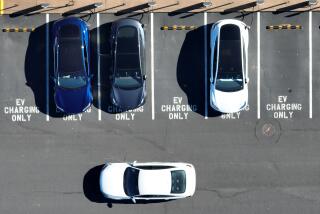BMW and VW team to build electric vehicle charging network
- Share via
Two German auto giants and America’s leading electric vehicle charging network have joined forces to build fast-charging EV networks along the country’s East and West coasts.
BMW of North America, Volkswagen of America and ChargePoint Inc. will construct up to 100 charging stations in “express charging corridors” from San Diego to Portland, Ore., on the West Coast and Boston to Washington on the East Coast.
Construction has already started on the Western corridor, where a string of new charging stations will allow vehicles to travel the length of California and into Oregon. As many as 100 stations will be up and running by the end of 2015, said Pasquale Romano, ChargePoint’s president and chief executive.
Each station will include one or two 50-kilowatt DC Fast chargers or 24-kilowatt DC Combo Fast chargers, developed by BMW in partnership with Bosch. Those chargers -- typically used for BMW and VW vehicles, as well as the Chevy Spark EV -- can bring a vehicle up to 80% power in less than 30 minutes.
Each station will also include some Level 2 chargers, which require up to four hours to fully charge a car. The Level 2 chargers can power up vehicles including the Chevy Volt, Nissan Leaf and the plug-in version of a Toyota Prius.
The goal is to serve all models of electric cars, even those made by Tesla Motors, which has its own supercharging network and its own proprietary charging ports.
The announcement was made Thursday morning during the 2015 Washington Auto Show.
The charging network is an effort to address one of the perceived principal blocks to greater EV adoption in the U.S. -- the problem of “range anxiety,” the fear of ending up out of juice and far from home.
To date, despite aggressive manufacturer discounts and government subsidies, plug-in vehicles make up fewer than 1% of total new-vehicle sales.
But sales are rising. Last year, they jumped 23%, according to the online research firm Inside EVs. More than 119,000 electric vehicles were sold.
By brand, Nissan’s Leaf led the segment in sales, with 30,200 units, with the Chevy Volt in second at 18,805 and Tesla’s Model S in third with 17,300.
This kind of network would go a long way toward relieving range anxiety, said Don Anair, deputy director of the clean vehicles program for the Union of Concerned Scientists, which monitors the adoption of alternative fuel vehicles.
More than 50% of respondents in a December 2013 Union of Concerned Scientists study said range was the principal reason they would not purchase or lease a plug-in electric car.
“This is likely to have a positive impact on electric vehicle adoption for consumers who are not moving to EVs because of that fear,” Anair said.
Consumers will be able to access the new networks with a ChargePoint or ChargeNow credit card, the companies said, or with a ChargePoint mobile app. As is the case with the estimated 20,000 Chargepoint stations currently in operation, some stations on the new network will be independently owned and will charge consumers for electricity, while others will be owned by the consortium and dispense electricity for free.
Funding for the network is being shared by all three companies, with BMW and VW paying for the bulk of it, Romano said.
EV segment leader Tesla has already built its own charging network. The company has 347 “Supercharger” stations nationwide -- the highest concentration being along the same corridors where BMW and VW plan to build their ChargePoint stations.
Tesla has announced plans to increase its number of charging stations on both coasts and much of the territory in between.
Tesla and the BMW-VW-Chargepoint consortium will supply a slowly but steadily growing community of electric vehicles. About 280,000 are estimated by ChargePoint to be currently on the road in the U.S.
In addition to enabling longer-distance driving, the new network could also be useful for shorter distances and around-town driving, particularly on the West Coast. In some cities, according to Kevin Wood, program manager at the Center for Sustainable Energy, EV penetration has outstripped infrastructure.
Only the most adventurous drivers are going to use the proposed new network to drive from Los Angeles to San Francisco, Wood said, because it would require too many stops and too much charging time. But the new network would be useful for EV drivers going from Orange County to San Diego, for instance.
The network also would reduce bad behavior at overtaxed charging stations, where reports of disagreements between charging customers are becoming more common.
“In California, it’s not uncommon to pull up at a bank of chargers and find them all occupied,” Wood said.
More stations can help alleviate “charge rage,” he said.
“When you’re out on the road and you need a charge, it’s frustrating if someone else is blocking the charger -- especially in the case of a car that has finished charging but someone has left the car there because it’s a convenient parking spot,” Wood said.
Romano sees the bright side of charge rage.
“I’m so happy the industry has enough utilization to even have this problem,” he said. “It’s a good sign, right? Because we’re using technology to solve a problem of demand.”
Twitter: @misterfleming







